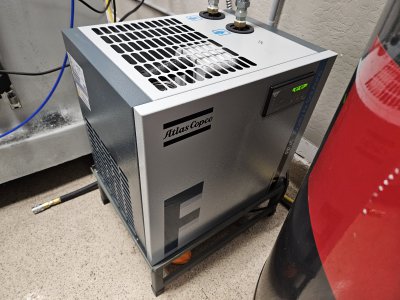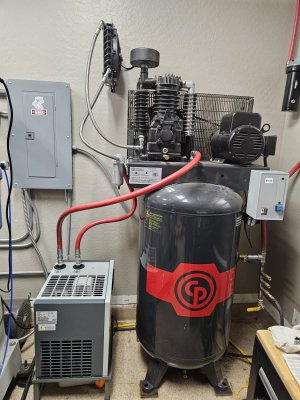- Joined
- May 7, 2020
- Messages
- 263
The air system has been running pretty well except for those larger plasma cutting jobs where we need the doors open for ventilation. We lost a few large parts due to the desiccant dryer getting saturated (yep, even here in Phoenix). Made the decision to buy a refrigerant dryer to get those dew points down and take the load off of our desiccant.
For those not familiar, a refrigerant dryer will run your compressed air through a set of coils very much like an air conditioner air handler - except under pressure. Will cool incoming air down to below 40 degrees and then separates out any condensed water. We installed a water holding tank under the dryer stand - the dryer has an auto drain line. In our case - a plasma cutter needs dry air for both cut quality and consumables life. Ruined parts are the net result if you have too much humidity in your compressed air. Paint shops will also use these dryers as that too requires dry air.
Talked to a few manufacturers and like the price and capacity of the Atlas Copco lineup. Took forever to get here but we installed our FD-10 today.

This unit will work well up to about 20 CFM (more than enough for our compressor) and cycles the compressor/fan when not in use. We decided to install downstream from the after-cooler and upstream from the pressure tank. That way, the tank will always have very dry air and that should help with longevity (no water, a lot less corrosion).
We have a water separator and a coalescing filter downstream from the after-cooler to remove as much water and oil as possible before the dryer does its magic. Before we feed the air to the plasma torch, we run through another set of filters and then through a 2-quart Desiccant dryer (which can reduce dew points to below freezing - quite the trick).
Here is the full installation:

Now I need to install one of those shower curtain shields that David Best uses to keep my dryer and 3-phase generator from dying a chip-induced early death - being so close to the mill. The things we do in a small shop!
If interested, the dry air saga starts here: https://www.hobby-machinist.com/threads/dry-shop-air-step-1-compressor-after-cooler.94795/
For those not familiar, a refrigerant dryer will run your compressed air through a set of coils very much like an air conditioner air handler - except under pressure. Will cool incoming air down to below 40 degrees and then separates out any condensed water. We installed a water holding tank under the dryer stand - the dryer has an auto drain line. In our case - a plasma cutter needs dry air for both cut quality and consumables life. Ruined parts are the net result if you have too much humidity in your compressed air. Paint shops will also use these dryers as that too requires dry air.
Talked to a few manufacturers and like the price and capacity of the Atlas Copco lineup. Took forever to get here but we installed our FD-10 today.

This unit will work well up to about 20 CFM (more than enough for our compressor) and cycles the compressor/fan when not in use. We decided to install downstream from the after-cooler and upstream from the pressure tank. That way, the tank will always have very dry air and that should help with longevity (no water, a lot less corrosion).
We have a water separator and a coalescing filter downstream from the after-cooler to remove as much water and oil as possible before the dryer does its magic. Before we feed the air to the plasma torch, we run through another set of filters and then through a 2-quart Desiccant dryer (which can reduce dew points to below freezing - quite the trick).
Here is the full installation:

Now I need to install one of those shower curtain shields that David Best uses to keep my dryer and 3-phase generator from dying a chip-induced early death - being so close to the mill. The things we do in a small shop!
If interested, the dry air saga starts here: https://www.hobby-machinist.com/threads/dry-shop-air-step-1-compressor-after-cooler.94795/
Last edited:

